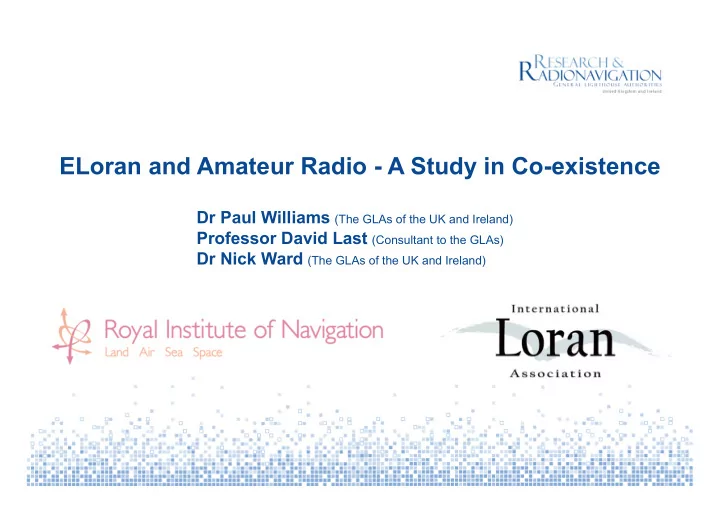

ELoran and Amateur Radio - A Study in Co-existence Dr Paul Williams (The GLAs of the UK and Ireland) Professor David Last (Consultant to the GLAs) Dr Nick Ward (The GLAs of the UK and Ireland)
Carrier-wave interference with Loran
Amateur Radio 135.7-137.8kHz Spectrum from 50kHz -150kHz
ITU Radio Regulations, Volume 1, Chapter 1, ‘Terminology and Technical Characteristics’, 2004
90kHz 110kHz Spectrum from 50kHz -150kHz near Anthorn
Spectrum from 135kHz -139kHz near Anthorn
100Hz-wide slice of spectrum at 100kHz near Anthorn
100Hz-wide slice of spectrum at 137kHz near Anthorn
Loop antenna rotated through 90 degrees
Groundwave propagation curves (from ITU 368-7)
Field Radiated strength power Single spectral line 6dBµV/m 50 µ Watt Whole amateur band 14mWatt (284 spectral lines) Radiated power from Anthorn in Radio Amateur Band
• Entire band only 2.1kHz wide • Data transmissions or V-E-R-Y S-L-O-W Morse code • Each dot 3-30 seconds, each dash 9-90 seconds • Bandwidth less than 1Hz • Visual reception Amateur Radio techniques at 136kHz
Waterfall diagram (from http://jpmere.online.fr/Grabber/Grabber.htm)
US Loran spectral lines (from http://www.imagenisp.ca/jsm/136.html)
Reception less than 1Hz from a Rugby Loran spectral line (from ttp://homepage.ntlworld.com/mike.dennison/index/lf/gallery/s52ab.htm)
Techniques for combating Loran! (from http://www.timewave.com/support/ANC-4/anc4.html & http://www.carc.org.uk/assets/Downloads/vlffilter.pdf)
• Anthorn’s Loran signal is correct • No spurious transmissions in the amateur band • Just 50µWatt per spectral line • Lessay, Ejde and Sylt pre-date Anthorn • Effective techniques to combat Loran • But still …
Recommend
More recommend